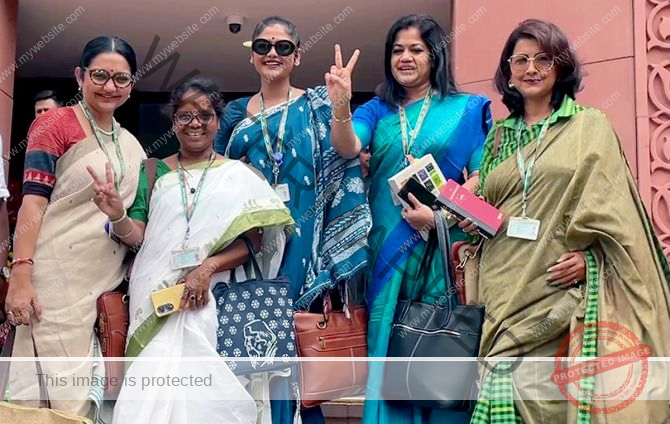Crime against women seems to have turned into a daily diet for media as well as the common man making both adjust to the brutal reality that the fair sex has to face and live with.
Successive governments over the years have tried to increase the representation of women in parliament, aimed at empowering women, but for patriarchal mindset having deep roots embedded in social fabric objecting to it in one or the other form.
Though the count of women Member of Parliaments has increased from 1st Lok Sabha to the 18th Lok Sabha, much more is yet to be done to realize the vision of women empowerment completely.
22 women MPs in first election
The first Lok Sabha elections were held in 1951-52. In country’s 1st Lok Sabha a total of 22 (4.4%) women MPs against a total strength 499 MPs were elected while elections to the 2nd Lok Sabha held in 1957 again saw 22 women reach Lok Sabha. The number of women MPs increased in the 3rd Lok Sabha to 31 in 1962 general elections.
However, the count of women MPs decreased in 4th Lok Sabha held in 1967 with only 29 women being elected as MPs. Further 5thLok Sabha constituted after 1971 general elections witnessed the count further decline to 21.
The lowest number of women MPs was in 6th Lok Sabha
Women representation declined in the 1977 Lok Sabha elections held after the Emergency. Only 19 women became MPs in the 6th Lok Sabha, the lowest count of women elected to Lok Sabha ever. All throughout 18 general elections, never in history of Lok Sabha did the count of women MPs fall below 20, except for in 1977.
Meanwhile, after hitting all time low, strength of women MPs increased once again in 7th Lok Sabha with 28 women being elected as Lok Sabha MPs in 1980. Thereafter women representation improved significantly with 42 women candidates reaching the 8th Lok Sabha in 1984. Women representation decreased once again in 1989 to 29 in the 9th Lok Sabha.
In the 10th Lok Sabha, polls for which were held in 1991, women’s representation increased to 33 while the 11th Lok Sabha in 1996 witnessed the count increased to 40. Elections for the 12th Lok Sabha were held in 1998 with 43 women MPs being elected followed by 49 women candidates winning in 13th Lok Sabha elections held in 1999.
In the 14th Lok Sabha held in 2004, the number of women MPs decreased to 45 while in 15th Lok Sabha the count reached to 59.
Most women became MPs in 2024
In 2014, the number of women MPs increased to 62 in 16th Lok Sabha followed by 78 women reaching Parliament in 17th Lok Sabha elections in 2019. The 18th Lok Sabha, results for which were declared on June 4 this year, 74 women MPs reached Lok Sabha comprising of 15.2% of the total strength while 31 women MPs were in Rajya Sabha making 13% of the total strength.
Women lawmakers around the World
As per 2023 data, countries with significant proportion of women lawmakers include Sweden (46%), South Africa (45%), UK (40%), Australia (38%), France (38%), Germany (35%), US (29%), Bangladesh (20%) and Pakistan (16%) respectively.
In contrast, India’s women’s representation in Parliament remains well below the global average of 26.5 per cent, or the Central and Southern Asia average of 19 per cent.
In Lok Sabha, the percentage of women members has risen from 5-10% registered until 2004 to 13.6% in the current 18th Lok Sabha, while in the Rajya Sabha, it was pegged at 13%. Also, the number of women contesting elections has shown a gradual increase over the past 15 years.
In 1957, just 45 women candidates contested Lok Sabha election which swelled to 799 (9.5% of the total candidates contested) in 2024.
Currently, West Bengal leads in having most women MPs, with 11 representatives. The Trinamool Congress has the highest proportion of women among its Lok Sabha MPs, at 38% in the 18th Lok Sabha, though it being far below the global average of around 26.5%.
Global Scenario
Reports revealed, India ranked 143 out of 185 countries in terms of women’s representation in the lower house of Parliament. Comparatively India lags behind countries like Vietnam, Philippines, Pakistan and China in gender representation.
Women’s Representation in State Legislatures
The national average of women’s representation in State Legislative Assemblies stands at a mere 9%, with no state having more than 20% women legislators. Even Chhattisgarh, the state with the highest representation, has only 18% women MLAs.
Women’s Reservation Act, 2023
On September 21, parliament witnessed passing of first legislation in the country’s new Parliament building, the Women’s Reservation Bill, 2023. The bill, which was passed almost unanimously by both houses of Parliament, with just two votes against it, mandates at least 33 per cent of women as part of total strength of Lok Sabha besides in state legislative assemblies also.
At the time of passing of the historic bill, Lok Sabha had around 14% women MPs in 17th Lok Sabha, India’s highest tally of women MPs since its independence.
Among 28 state assemblies last year, Chhattisgarh had the highest level of women legislators pegged at 18 per cent while on the contrary Himachal Pradesh had just one woman legislator and Mizoram having none.
As per the Act, in every election 33 per cent of the seats in Lok Sabha as well as state assemblies were to be reserved compulsorily for women.
The bill became law with the 106th Constitutional Amendment (2023) proposing one-third reservation of seats for women in the Lok Sabha and state legislative assemblies.
However, it will take effect after the next census, following which delimitation will be carried out to reserve seats for women for a period of 15 years. With reservation law in place, India will have around 180 women MPs.
The Women’s Reservation Bill was introduced five times in 1996, 1998, 2009, 2010 and 2014 but lack of political consensus among major parties failed to see it translate into Act.
What Women Rights Activist feel
Says Women Rights Activist and advocate, Allahabad high court Sheeba Jose, “a minimum one-third representation of women in Lok Sabha as well as State legislative assemblies is a necessity. The Kolkata rape and murder case of the junior doctor is a tell-tale of the status of women in a patriarchal society where objectification of women is done by several mediums be it social media platform, movies or the internet. Strict laws to deal with crime against women and cleansing of political system wherein people with declared cases of crime against women not being elected as representatives of masses in Lok Sabha should be ensured,”
Women MPs in Lok Sabha
| Lok Sabha | Women MPs |
| 1 | 22 |
| 2 | 22 |
| 3 | 31 |
| 4 | 29 |
| 5 | 21 |
| 6 | 19 |
| 7 | 28 |
| 8 | 42 |
| 9 | 29 |
| 10 | 33 |
| 11 | 40 |
| 12 | 43 |
| 13 | 49 |
| 14 | 45 |
| 15 | 59 |
| 16 | 62 |
| 17 | 78 |
| 18 | 74 |






























